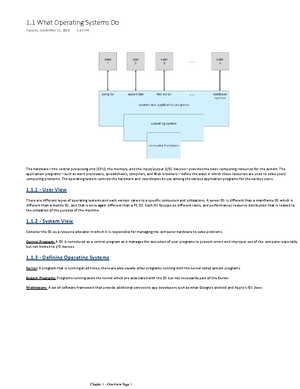- Information
- AI Chat
Was this document helpful?
Quiz 1 Notes
Course: Operating Systems Principles (CSCI 340)
16 Documents
Students shared 16 documents in this course
University: Queens College CUNY
Was this document helpful?

CS340 Quiz 1 Notes
Batch processing = uses FCFS (first come-first serve) job queue; jobs with similar needs were
batched together and run as group; automatically transfers control from 1 job to the next;
LITTLE TO NO INTERACTION BETWEEN USER AND JOB
●NOT used anymore
●Examples: transactions of credit cards, generation of bills, processing of input/output in
the OS
Multi programming = 1 CPU but multiple processes ready for execution while using priority
algorithm; priority is given to process that needs resource most
●Timesharing = multiprogramming system that supports multiple terminals, 1 for each
active user of system; uses round robin- scheduling algorithm that uses queue to
execute process within some time frame (may be complete, may not be); 1 CPU but
multiple users
Multi processing = many CPUs to increase processing power; share resources such as
computer bus, clock, memory and peripheral devices.
Boot time process =
1. when computer starts, CPU goes to location in ROM and finds set of instructions.
2. Those instructions are checked by POST (power-on-self-test)
3. CPU goes to second hardware location that had Master Boot Record that points to
location of Bootstrap program
4. Bootstrap program executes by CPU
5. Bootstrap program locates kernel and loads kernel into memory
Bootstrap program = program that should be executed and its stored in ROM (read-only
memory)
Modern architecture for us is set of instructions -> POST (power on self test) -> hardware is
checked -> master boot record -> point to location of complete bootstrap program
Master Boot Record = (MBR) will point into the location of a complete bootstrap program
Interrupt vector = memory location of an interrupt handler; list of interrupts that system must
take action for.
●Connects ID of interrupt with memory location of an interrupt handler (or executable file)
that will handle interrupt
Dual-Mode processor = A mode bit is added to hardware of computer to indicate current mode.
Has 2 modes- user mode 1 (operation is done on behalf of user) and system mode 0
(operation (also privileged) is done on behalf of OS). Reason for using it is to have system






